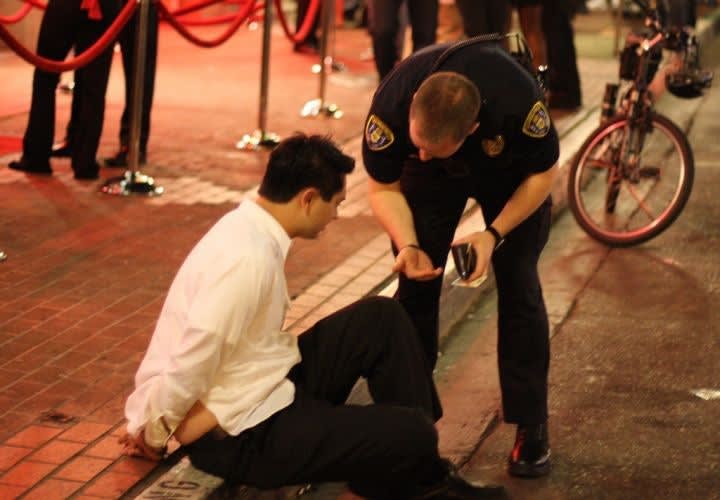On June 1, 2010, the Supreme Court decided an important Miranda case arising from a Michigan murder case. Here are the facts:
Exclusive: What the Supreme Court's New Miranda Decision Means to You
This significant new decision firmly establishes that once a suspect has received the Miranda warnings and indicates that he understands his rights, officers are not required to ask whether he wishes to waive or invoke but may simply start asking questions about the case.

Photo via Flickr (San Diego Shooter).
Chester Thompkins was arrested and given a standard Miranda warning and gave evidence that he understood his rights. Officers made no effort to obtain an express waiver but began asking questions. For some two hours and 45 minutes, Thompkins was essentially non-responsive, although he occasionally nodded his head or said "I don't know," or "Yes" or "No" to something the officers said. Then, officers asked if he believed in God and would pray to God to forgive him "for killing that boy." Thompkins said he would.
This answer was used at trial to convict Thompkins of murder. His appeals took him to the U.S. Supreme Court, where he made several arguments of Miranda error. By 5-4 decision, the court held that no Miranda error occurred.
First, Thompkins argued that he effectively invoked his right to silence by actually remaining silent. The court majority rejected this argument and ruled that in order for a custodial suspect to invoke either his right to counsel or his right to silence, he must unambiguously communicate his desire to do so. For example, he could have said, "I don't want to talk," or "I want a lawyer." Because he did neither, the court held that he failed to invoke his Miranda rights.
Second, Thompkins argued that because he never gave a waiver, officers could not proceed with interrogation. This argument was also rejected by the court. The court pointed out that one of its previous decisions had held that a Miranda waiver may be either express or implied. A waiver is "express" when the suspect is specifically asked after warnings and acknowledgment of understanding whether he wants to talk about what happened, and expressly says he is willing. A waiver is "implied" when the suspect is warned and acknowledges his understanding of his rights and then answers questions put to him, without first being asked whether he agrees to talk. In this case, the court ruled that Thompkins gave an implied waiver by eventually responding to the officers' questions.
Third, Thompkins argued that his statement was involuntary because officers referred to his religious beliefs to prompt him to incriminate himself. Again citing to one of its previous cases, the court said that there was nothing improper in this tactic, since only "coercion emanating from official sources" could cause a statement to be involuntary.
This significant new decision firmly establishes that once a suspect has received the Miranda warnings and indicates that he understands his rights, officers are not required to ask whether he wishes to waive or invoke but may simply start asking questions about the case. If a statement is ultimately obtained, it will be admissible under Miranda.
(This case and the issues will be examined in greater detail in the " Point of Law " department in a forthcoming issue of POLICE magazine.)
Do you agree with the Court's decision? Vote in our Web Poll.
More Blogposts
Preventing Heat Injury in Police K-9s
In the relentless heat of summer and even early fall in some parts of the country, officers face the important task of protecting their K-9 partners while working in sweltering temperatures. Recognizing changes in a dog’s behavior is the key.
Read More →Why Your Agency Needs to Attend the ILEETA Conference
ILEETA is a complete resource for trainers to address trainers' needs. Its mission is to enhance the skills and safety of criminal justice practitioners while fostering stronger and safer communities.
Read More →IACP 2023: New Training Products
Technologies for improving law enforcement training and training management were some of the highlights at this year's show.
Read More →Initial Results Released from MSP 2024 Police Vehicle Testing
The 2024 pursuit-rated vehicles--all pickup trucks or SUVs, including two battery electric models the Chevrolet Blazer EV AWD and Ford Mustang Mach-E--were put through their paces.
Read More →Officer Safety Considerations Related to Alternative-Fuel Vehicles
As more alternative-fuel and hybrid vehicles hit the road, police and other first responders need to understand that they are no more dangerous than conventional vehicles. However, there are certain safety considerations every cop should know.
Read More →Garmont Working to Grow LE Market Presence
Garmont Tactical has found wide acceptance by military boot buyers, but now the company is trying to better respond to the needs of police officers. Many cops now are not fans of 8-inch boots, so Garmont is adapting.
Read More →Publisher’s Note: Our Commitment to You
Through our magazine and website and our Police Technology eXchange event, we promise to provide you with information and access to resources to help you do your job safer and better.
Read More →10 Tips for Responding to Mental Health Crisis Calls
The Harris County Sheriff's Office is a model for other agencies that want to learn about crisis intervention and mental health crisis response. Sgt. Jose Gomez shares the story of their programs and provides 10 tips for mental health crisis call response
Read More →5 Things to Know When Buying Concealed-Carry or Off-Duty Holsters
Mike Barham, of Galco Holsters, shares five important considerations to keep in mind when you buy off-duty concealed or plain-clothes carry holsters.
Read More →10 Tips for Reviewing Use-of-Force Reports
While the burden of accurately reporting use-of-force situations is on an individual deputy or officer, the person reviewing those reports shares in the responsibility of making sure the reporting is done properly, with clear details included.
Read More →











